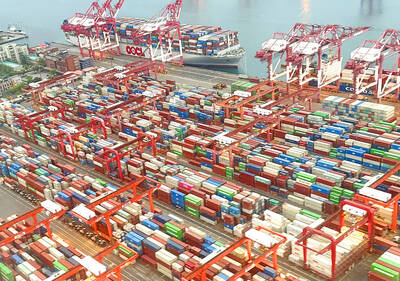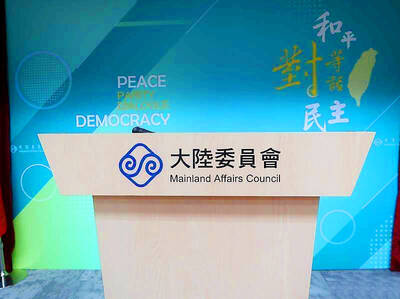The government will not “directly” resume talks with China over a cross-strait trade in goods agreement until a supervisory bill clears the legislative floor, Minister of Economic Affairs Lee Chih-kung (李世光) said on Friday last week.
“We will continue making progress on the cross-strait trade in services and goods pacts when a draft bill of supervisory regulations on cross-strait agreements secures legislative approval,” Lee told a media gathering after he took office on Friday morning.
In other words, the ministry is not restarting formal negotiations over the trade in goods agreement with China for the time being, he said.
From now on, the government will discuss all cross-strait economy-related issues as part of a cross-ministry platform at the Executive Yuan, Lee said.
The ministry has started to analyze the feasibility of easing restrictions on Chinese investment in Taiwan’s industries and regulations on China-bound investment and is to present the results to the platform for deliberation, he said.
He said the government is not “disagreeing” with the idea of opening Taiwan’s markets, but the nation’s industries must become stronger before being exposed to global markets.
If the nation’s industries are not globally competitive, there would be limited products the government can use to negotiate reciprocal terms with other nations, he said.
In an effort to push the government’s “new southbound policy,” Lee said the ministry has reviewed a few local companies’ projects that the new policy could apply to.
Lee said the “new southbound policy” is not simply an economic policy, as the government also has to consider the interests of other nations and overseas Taiwanese businesspeople.
The ministry is to help overseas Taiwanese businesspeople communicate their needs and assist them in operations in accordance with the government’s plans, he said.
Commenting on the government’s energy policy, Lee said that the ministry would play the most important role in developing and promoting “green” energy in the nation, as the government plans to phase out nuclear power and fossil-fuel-based power plants.
Lee said the government would not immediately reduce electricity contribution from fossil-fuel power plants after nuclear power plants are retired in 2025, adding that there is time for the government to develop renewable energy generation.
Solar power would be one of the first renewable energy sources that the government plans to focus on, as many Taiwanese manufacturers already have adequate knowledge and technologies, Lee said.
Given that eight out of the world’s 10 best offshore wind farm locations are on Taiwan’s coast, the government also plans to invest in the development of offshore wind energy, Lee said.
As the government plans to increase the power contribution from renewable energy sources, it would also help to develop the nation’s green energy industry by localizing the supply chains of Taiwan’s industries, Lee said.
The government aims to expand the localization rate of offshore wind farm supply chains to 81 percent by 2020 from this year’s target of 16 percent, he said.
This would create new job opportunities, while also accelerating the development of the green energy industry in Taiwan, he added.

MORE VISITORS: The Tourism Administration said that it is seeing positive prospects in its efforts to expand the tourism market in North America and Europe Taiwan has been ranked as the cheapest place in the world to travel to this year, based on a list recommended by NerdWallet. The San Francisco-based personal finance company said that Taiwan topped the list of 16 nations it chose for budget travelers because US tourists do not need visas and travelers can easily have a good meal for less than US$10. A bus ride in Taipei costs just under US$0.50, while subway rides start at US$0.60, the firm said, adding that public transportation in Taiwan is easy to navigate. The firm also called Taiwan a “food lover’s paradise,” citing inexpensive breakfast stalls

TRADE: A mandatory declaration of origin for manufactured goods bound for the US is to take effect on May 7 to block China from exploiting Taiwan’s trade channels All products manufactured in Taiwan and exported to the US must include a signed declaration of origin starting on May 7, the Bureau of Foreign Trade announced yesterday. US President Donald Trump on April 2 imposed a 32 percent tariff on imports from Taiwan, but one week later announced a 90-day pause on its implementation. However, a universal 10 percent tariff was immediately applied to most imports from around the world. On April 12, the Trump administration further exempted computers, smartphones and semiconductors from the new tariffs. In response, President William Lai’s (賴清德) administration has introduced a series of countermeasures to support affected

CROSS-STRAIT: The vast majority of Taiwanese support maintaining the ‘status quo,’ while concern is rising about Beijing’s influence operations More than eight out of 10 Taiwanese reject Beijing’s “one country, two systems” framework for cross-strait relations, according to a survey released by the Mainland Affairs Council (MAC) on Thursday. The MAC’s latest quarterly survey found that 84.4 percent of respondents opposed Beijing’s “one country, two systems” formula for handling cross-strait relations — a figure consistent with past polling. Over the past three years, opposition to the framework has remained high, ranging from a low of 83.6 percent in April 2023 to a peak of 89.6 percent in April last year. In the most recent poll, 82.5 percent also rejected China’s

PLUGGING HOLES: The amendments would bring the legislation in line with systems found in other countries such as Japan and the US, Legislator Chen Kuan-ting said Democratic Progressive Party (DPP) Legislator Chen Kuan-ting (陳冠廷) has proposed amending national security legislation amid a spate of espionage cases. Potential gaps in security vetting procedures for personnel with access to sensitive information prompted him to propose the amendments, which would introduce changes to Article 14 of the Classified National Security Information Protection Act (國家機密保護法), Chen said yesterday. The proposal, which aims to enhance interagency vetting procedures and reduce the risk of classified information leaks, would establish a comprehensive security clearance system in Taiwan, he said. The amendment would require character and loyalty checks for civil servants and intelligence personnel prior to